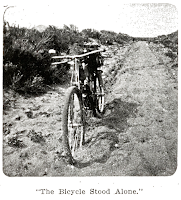"After having breakfast in the boxcar restaurant, I left Bitter Creek for Rawlins. In this stretch, about 20 miles from Bitter Creek, I crossed my third desert, the Red Desert of Wyoming. It takes its name from the soil of calcareous clay that is fiery red, and the only products of which are rocks and
 |
| G.Wyman |
It was along this fine stretch, just before reaching Creston, that I came to the
 |
| G.Wyman |
 |
| G.Wyman |
From Creston to Rawlins there is nearly 30 miles of downgrade, and, as it is a fairly good highway of gravel, I made lively time over it. After leaving Creston there come Cherokee and Daly's ranch before you get to Rawlins, and it was between these places, both mere railroad points, that I got the picture of the abandoned prairie schooner that was printed in Motorcycle Magazine. Rawlins, where I stopped only for gasoline, is a town of some size, having more than 2,000 population. From there the country becomes rolling again, and after passing Fort Fred Steele, I began to ascend once more. It is a great sheep ranch country all through here now from Rawlins. At Fort Steele there is nothing left but the ruins of abandoned houses. I now follow the old immigrant trail that winds across the River Platte, and am fast approaching the Laramie Plains, over which my route lies to the Laramie Mountains. Beyond Fort Steele I enter White Horse Canyon, which got its name, so the story goes, from an Englishman, one of the sort known in the West as "remittance men," who drank too much "Old Scratch," and, mounted on a white horse, rode over the precipice and landed on the rocks 200 feet below.
 At 6:10 p.m. I reached Walcott, a "jerkwater" settlement, composed of two saloons, a store and a railroad station. It is made important, though, by the fact that two stage lines come in there. The hotels at places of the sort are generally clean, and they are kept more-or-less peaceable by the policy of reserving an out-building for the slumbers of the "drunks," so I concluded to tarry. I found some interest in automobiles here, and, after inspecting my machine, the natives fell to discussing the feasibility of running automobiles on the stage lines, instead of the old Concord coaches, drawn by six horses, that are now used. One of the stage drivers said that if anyone would build an automobile that would carry 12 or 14 persons and run through sand six inches deep. He would pay from $3,000 to $5,000 for it. I told him to wait awhile. After supper I mended my broken spokes with telegraph wire, and entertained quite a group of spectators, who watched the job with open curiosity. I find a variable reception in this country to my statement that I have journeyed from San Francisco, and am bound for New York. A great many do not believe me, and smile as if amused by an impromptu yarn. There is another class, though, that of the old settlers, the real mountaineers who have had adventures of all sorts in the mountains and the wilderness. These men are surprised at nothing, and they rather nettle me by accepting me and my motor bicycle and my statement with utmost stolidity as if the feat was commonplace. For awhile I thought that this class, too, were unbelievers, but later I learned that as a rule they are the only ones who do believe me, because they are men who believe anything possible in the way of overland journeying."
At 6:10 p.m. I reached Walcott, a "jerkwater" settlement, composed of two saloons, a store and a railroad station. It is made important, though, by the fact that two stage lines come in there. The hotels at places of the sort are generally clean, and they are kept more-or-less peaceable by the policy of reserving an out-building for the slumbers of the "drunks," so I concluded to tarry. I found some interest in automobiles here, and, after inspecting my machine, the natives fell to discussing the feasibility of running automobiles on the stage lines, instead of the old Concord coaches, drawn by six horses, that are now used. One of the stage drivers said that if anyone would build an automobile that would carry 12 or 14 persons and run through sand six inches deep. He would pay from $3,000 to $5,000 for it. I told him to wait awhile. After supper I mended my broken spokes with telegraph wire, and entertained quite a group of spectators, who watched the job with open curiosity. I find a variable reception in this country to my statement that I have journeyed from San Francisco, and am bound for New York. A great many do not believe me, and smile as if amused by an impromptu yarn. There is another class, though, that of the old settlers, the real mountaineers who have had adventures of all sorts in the mountains and the wilderness. These men are surprised at nothing, and they rather nettle me by accepting me and my motor bicycle and my statement with utmost stolidity as if the feat was commonplace. For awhile I thought that this class, too, were unbelievers, but later I learned that as a rule they are the only ones who do believe me, because they are men who believe anything possible in the way of overland journeying."Across America on a Motor Bicycle - "Over the Rockies and the Great Divide to the Prairies" by George A. Wyman, The Motorcycle Magazine, August 1903, Vol 1 No 3
Ogden, UT to Omaha, NE
May 28 to June 11, 1903




















